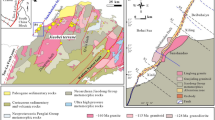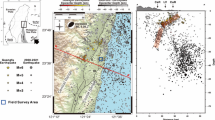Abstract
The Baiyun Sag is the deepest sag in the Pearl River Mouth Basin in northern continental margin of South China Sea, with the maximum sediment thickness over 12.5 km above the basement including >6.5 km sediments above the 30 Ma breakup unconformity. According to the theoretical models for the rifted basins, the post-rift subsidence is driven solely by the thermal contraction and can be calculated as the function of the lithospheric stretching factor. A method combining the forward modeling and reverse backstripping was designed to estimate lithospheric stretching factor. Using the 2D forward modeling based on the flexural cantilever model, we simulated the multi-rifting process of the Baiyun Sag with constrain of the backstripped profiles. By doing this the lithospheric stretching factor was obtained, and then the theoretical post-rift subsidence was calculated. The calculated theoretical subsidence was much smaller than the observed subsidence given by backstripping. Along the 1530 line in the Baiyun Sag, the anomalous post-rift subsidence is over 2 km in the sag center, and varies slightly to the north and south edges of the sag. This suggests that the anomalous post-rift subsidence continues beyond the sag both in the continental shelf to the north and in the continental slope to the south. The sensitivity tests in the forward modeling process indicate that only the use of low-angle faults (⩽13°) can we simulate the shape of the backstripped profile.
Similar content being viewed by others
References
Ceramicola S, Stoker M, Praeg D, et al. Anomalous cenozoic subsidence along the ‘passive’ continental margin from Ireland to mid-Norway. Mar Petrol Geol, 2005, 222: 1045–1067
Morley C K, Westaway R. Subsidence in the super-deep Pattani and Malay basins of Southeast Asia: A coupled model incorporating lower-crustal flow in response to post-rift sediment loading. Basin Res, 2006, 18: 51–84
Xie X N, Müller R D, Li S T, et al. Origin of anomalous subsidence along the Northern South China Sea margin and its relationship to dynamic topography. Mar Petrol Geol, 2006, 23: 745–765
Cui T, Xie X N, Ren J Y, et al. Dynamic mechanism of anomalous post-rift subsidence in the Yinggehai Basin (in Chinese). Earth Sci—J China Univ Geosci, 2008, 33: 349–356
McKenzie D P. Some remarks on the development of sedimentary basins. Earth Planet Sci Lett, 1978, 40: 25–32
Kusznir N J, Marsden G, Egan S S. A flexural-cantilever simple-shear/pure-shear model of continental lithosphere extension: Applications to the Jeanne d’Arc Basin, Grand Banks and Viking Graben, North Sea. In: Roberts A M, Yielding G, Freeman B, eds. The Geometry of Normal Faults. London: Geol Soc London Spec Publ, 1991. 41–60
Lin C S, Zhang Y M, Li S T, et al. Quantitative modelling of multiphase lithosphere stretching and deep thermal history of some tertiary rift basins in eastern China. Acta Geol Sin, 2002, 76: 324–330
Zhou D, Sun Z, Liao J, et al. Filling history and post-breakup acceleration of sedimentation in the Baiyun Sag, deep-water northern South China Sea. Earth Sci—J China Univ Geosci, 2009, 20: 160–171
Pang X, Chen C M, Peng D J, et al. The Pearl River Deep-Water Fan System & Petroleum in South China Sea (in Chinese). Beijing: Science Press, 2007
Sclater J G, Christie P A F. Continental stretching: An explanation of the post-Mid-Cretaceous subsidence of the central North Sea basin. J Geophys Res, 1980, 85(B7): 3711–3739
Huang C J, Zhou D, Chen C M, et al. Deep crustal structure of Baiyun Sag revealed by deep reflection seismic profile. Chin Sci Bull, 2005, 50: 1131–1138
Sun Z, Pang X, Zhong Z H, et al. Dynamics of Tertiary tectonic evolution of the Baiyun Sag in the Pearl River Mouth Basin (in Chinese). Earth Sci Front, 2005, 12: 489–498
Chen C M, Shi H S, Xu S C, et al. The Formation Conditions of the Tertiary Oil-Gas Reserviors in Pearl River Mouth Basin (East) (in Chinese). Beijing: Science Press, 2003
Yao B C. Preliminery study of the Cenozoic tectonice movements in the northern continental margin of South China Sea (in Chinese). Geol Res South China Sea, 1993, 5: 1–12
Pang X, Chen C M, Shao L, et al. Baiyun Movement, a great tectonic event on the Oligocene-Miocene boundary in the northern South China Sea and its implications (in Chinese). Geol Rev, 2007, 53: 145–151
He L J, Xiong L P, Wang J Y, et al. Tectono-thermal modeling of Yinggehai Basin. Sci China Ser D-Earth Sci, 2001, 44: 7–13
Briais A, Patriat P, Tapponnier P. Updated interpretation of magnetic anomalies and seafloor spreading stages in the South China Sea—Implications for the Tertiary tectonics of Southeast Asia. J Geophys Res, 1993, 98(B4): 6299–6328
Cande S C, Kent D V. Revised calibration of the geomagnetic polarity timescale for the Late Cretaceous and Cenozoic. J Geophys Res, 1995, 100: 6093–6095
Clift P D, Lin J. Preferential mantle lithospheric extension under the South China margin. Mar Petrol Geol, 2001, 18: 929–945
Shao L, Li X H, Wang P X, et al. Sedimentary record of the tectonic evolution of the South China Sea since the Oligocene—Evidence from deep sea sediments of ODP site 1148 (in Chinese). Adv Earth Sci, 2004, 19: 539–544
Kusznir N J, Roberts A M, Morley C K. Forward and reverse modelling of rift basin formation. J Geol Soc London Spec Publ, 1995, 80: 33–56
Roberts A M, Kusznir N J, Yielding G, et al. 2D flexural backstripping of extensional basins: The need for a sideways glance. Petrol Geosci, 1998, 4: 327–338
Jarvis J T, McKenzie D P. Sedimentary basin formation with finite extension rates. Earth Planet Sci Lett, 1980, 48: 42–52
Zhou D, Hu D K, He M, et al. The selection of fitting curve in time-depth transformation of deep-seated strata and crust (in Chinese). Earth Sci Front, 2008, 33: 531–537
Qin G Q. Application of micropaleontology to the sequence stratigraphic studies of late Cenozoic in the Pearl River Mouth Basin (in Chinese). Mar Geol Quat Geol, 1996, 16: 1–18
Pang X, Chen C M, Shi H S, et al. Response between relative sea-level change and the Pearl River deep water fan systerm in the South China Sea (in Chinese). Earth Sci Front, 2005, 12: 167–176
Haq B U, Hardenbol J. Mesozoic and Cenozoic chronostratigraphy and cycles of sea-level change. Soc Econ Paleont Mineral, 1988, 42: 71–108
Clift P D, Lin J, Barckhausen U. Evidence of low flexural rigidity and low viscosity lower continental crust during continental break-up in the South China Sea. Mar Petrol Geol, 2002, 19: 951–970
Pang X, Chen C M, Peng D J, et al. The Pearl River Deep-water Fan System & Petroleum in South China Sea (in Chinese). Beijing: Science Press, 2007
Kusznir N J, Hunsdale R, Roberts A M, et al. Norway margin depth-dependent stretching. In: Dore A G, Vining B A, eds. Petroleum Geology: North-West Europe and Global Perspectives-Proceedings of the 6th Petroleum Geology Conference. Geol Soc London, 2005. 767–783
Jin W S, Sun D Z, Wang Z W, et al. The Deep Crustal Structure and Its Evolution of South China (in Chinese). Beijing: Geological Publishing House, 1997
Zhao Z X, Zhou D, Liao J, et al. Lithospheric stretching modeling and post-breakup subsidence analysis in continental shelf, Pearl River Mouth Basin (in Chinese). Acta Geol Sin, 2010, 84: 1135–1145
Shi X B, Burov E, Leroy S, et al. Intrusion and its implication for subsidence: A case from the Baiyun Sag, on the northern margin of the South China Sea. Tectonophysics, 2005, 407: 117–134
Burgess P M, Gurnis M, Moresi L. Formation of sequences in the cratonic interior of North America by interaction between mantle, eustatic, and stratigraphic processes. Geol Soc Am Bull, 1997, 109: 1515–1535
Lithgow-Bertelloni C, Gurnis M. Cenozoic subsidence and uplift of continents from time-varying dynamic topography. Geology, 1997, 25: 735–738
Zhou D, Wang W Y, Wang J L, et al. Mesozoic subduction-accretion zone in northeastern South China Sea inferred from geophysical interpretations. Sci China Ser D-Earth Sci, 2006, 49: 471–482
Praeg D, Stoker M S, Shannon P M, et al. Episodic cenozoic tectonism and the development of the NW European ‘passive’ continental margin. Mar Petrol Geol, 2005, 22: 1007–1030
Ross A R, Brown L D, Pananont P, et al. Deep reflection surveying in central Tibet: Lower-crustal layering and crust flow. Geophys J Int, 2004, 156: 115–128
McKenzie D P, Nimmo F, Jackson J A, et al. Characteristics and consequences of flow in the lower crust. J Geophys Res, 2000, 105: 11029–11046
Westaway R. Geomorphological consequences of weak lower continental crust, and its significance for studies of uplift, landscape evolution, and the interpretation of river terrace sequences. Netherlans J Geosci, 2002, 81: 283–303
Westaway R. The quaternary evolution of the gulf of Corinth, central Creece: Coupling between surface processes and flow in the lower continental crust. Tectonophysics, 2002, 348: 269–318
Zhang Y F, Sun Z, Zhou D, et al. Stretching characteristics and its dynamic significance of the northern continental margin of South China Sea. Sci China Ser D-Earth Sci, 2008, 51: 422–430
Clift P D, Lee J I, Clark M K, et al. Erosional response of South China to arc rifting and monsoonal strengthening: A record from the South China Sea. Mar Geol, 2002, 184: 207–226
Clift P D. Controls on the erosion of Cenozoic Asia and the flux of clastic sediment to the ocean. Earth Planet Sci Lett, 2006, 241: 571–580
Author information
Authors and Affiliations
Corresponding author
Rights and permissions
About this article
Cite this article
Liao, J., Zhou, D., Zhao, Z. et al. Numerical modeling of the anomalous post-rift subsidence in the Baiyun Sag, Pearl River Mouth Basin. Sci. China Earth Sci. 54, 1156–1167 (2011). https://doi.org/10.1007/s11430-011-4184-3
Received:
Accepted:
Published:
Issue Date:
DOI: https://doi.org/10.1007/s11430-011-4184-3




